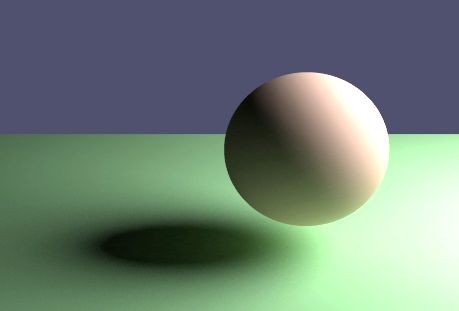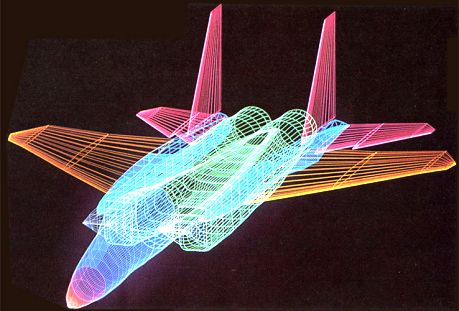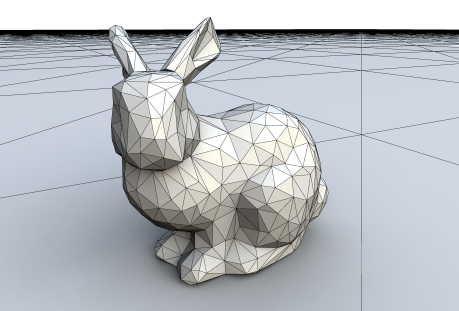Graphics
Universiteit Utrecht - Information and Computing Sciences
academic year 2015/16 – 4th period
 |
 |
 |
GraphicsUniversiteit Utrecht - Information and Computing Sciencesacademic year 2015/16 – 4th period |
|||
|
Navigation |
||||||||
|
|
||||||||
News |
|
Recent news July 2:
 July 1:
older posts still available here. |
Course Overview
|

Course: "Graphics" is an introductory course about computer graphics. Computer graphics deals with the algorithmic processing of visual (images) and spatial (geometry) data. The course will focus on the very basics of modeling and rendering, i.e., the mathematical description of three-dimensional scenes and how to create (realistic) images of such models. Rendering Algorithms: We have several
options to convert the mathematical representation of a
virtual world into a digital image. Modern games typically
rely on the z-buffer algorithm. An alternative approach is
ray tracing. In this course we will explore both methods.
Ray tracing allows us to produce 'correct' images;
rasterization lets us approximate this in real-time. Math: An important aspect of computer graphics is the use of mathematics. This course provides a short coverage of the mathematical basics needed for rendering. We will introduce fundamental concepts of linear algebra and other areas of higher mathematics that are important far beyond the field of graphics. The lecture will be given in Dutch. Het officiële rooster is beschikbaar via Osiris.
officiële cursusinformatie via www.cs.uu.nl.
Klik hier voor de lijst
van studenten voor dit vak. |
Lecture
|
|
Lecturer: Jacco Bikker (j.bikker@uu.nl) Teaching Assistants: Lecture:
Practicals tutorial/consultation hours
|
Topics
|
|
|
|
|
The list is intended to give a rough orientation; topics might still be subject to change, and additional aspects might be covered. |
Lecture Slides & Recommended
Readings
|
|
Below is a list of all lectures
with a very brief summary of the topics, slides downloads,
and recommended readings to prepare for the lecture. |
|
||||||||
|
|
|||||||
|
|
| Midterm
Exam Tue, May 24 |
|
Midterm Exam:
Tue May 24 2016, 11:00-13:00 in EDUC-GAMMA. What to study: Slides for lectures 1-7, suggested readings for these lectures, tutorials 1 and 2. For this exam, you are not
allowed to bring notes. |
|
|
|
| Final Exam Thu, June 30 |
|
Final Exam: Thu June 30 2016, 17:00-20:00, in EDUC-BETA. |
| Retake Exam Thu, July 14 |
|
Retake Exam: Thu
July 14 2016, 13:30-16:30, in OLYMPUS-M.BUITING |
Course Schedule
|
|||||||||||||||||||||||||||||||||||||||||||||||||||||||||||||||||||||||||||||||||||||||||||||||||||||||||||||||||||||||||||
|
Period 4 Schedule
|
|||||||||||||||||||||||||||||||||||||||||||||||||||||||||||||||||||||||||||||||||||||||||||||||||||||||||||||||||||||||||||
Tutorials
|
|
Overview During the course we will hand out tutorial sheets.
Assignment Sheets / Downloads
|
Practicals
|
|
PRACTICAL ASSIGNMENTS There will be three practical assignments, covering traditional rasterization algorithms, shaders and ray tracing. The first assignment will be online on Tuesday, April 26. We recommend that you start working on it right away. Practicals tutorial/consultation hours On Tuesdays, teaching assistants will be present in various rooms to help you if you have questions. These practical tutorials are offered after the lectures on Tuesdays. Please see the schedule for a list of available rooms for each week. Remarks:
Important Rules Because of the large group of students taking this lecture, we need strict rules to keep everything manageable. The most important rules are listed below. Further explanations might be given during the lecture.
Soft- / Hardware and Infrastructure:
Forum: There is an online discussion forum where the TAs and
lecturer answer your questions (this is a best-effort
offer; no guarantees; in particular, close to deadlines): www.projects.science.uu.nl/gmt You can also join us on Slack using your @uu.nl address: Assignments: Assignment P1: OpenTK
Tutorial
|
|
|
|
|
The first assignment is a
tutorial introducing basic 2D graphics, coordinate
systems, and OpenTK. OpenTK allows us to create OpenGL
applications in C#. Details for the assignment are in the
document which you can download below. Files: Deadline(s):
The second assignment is all
about ray tracing. Full details are in the assignment
description which you can download below. Files:
Deadline(s):
For the third and final
assignment, you will be creating a small 3D engine based
on the supplied template. Files:
Deadline(s):
|
Exam & Grading
|
|
GRADING Programming assignments: There will be three programming assignments throughout the semester. The final grading P for your programming assignments makes up 1/3 of your overall grade for this course. It is calculated as follows: P=0.2*P1+0.4*P2+0.4*P3. P must be at least 5.0 (before rounding) to pass the course. Exams: There will be a midterm exam T1
and a final exam T2. The final grading T for your exams
makes up 2/3 of your overall grade for this course. It is
calculated as follows: T = 0.5*T1 + 0.5*T2. T must be at
least 5.0 (before rounding) to pass the course. Final grade: If both T (= the grade for
the written exams) and P (= the programming grade) are at
least 5.0, the final grade for the course is (2T + P) / 3.
Your final grade must be at least 6 (after rounding) to
pass the course. RETAKES AND REQUIREMENTS If you did not pass the course but your final
grade for the course is at least 4.0 (before
rounding), you are entitled to participate in a retake.
This can either be a retake assignment or a retake exam. Retake (exam) T3: This exam will cover all lectures and tutorials. The result from your retake exam T3 will replace the lower one of your original scores, i.e. either T1 or T2 if and only if it improves your final grade. Criteria for passing stay the same as indicated above (i.e. P and T must be at least 5.0 before rounding, and your final grade must be at least 6 after rounding). Retake (practicals): There will be one retake assignment that can replace either P1, P2, or P3 if it improves your final grade. The topic for the retake assignment is decided individually. To get your assignment and related deadlines, contact the instructor. Exceptions: Exceptions to these rules in
principle always require involvement of the study coach. Results To be released.
|
Literature & Links
|
|
Textbook:
Additional resources for the practicals: Resources that might be helpful, especially for programming assignment 2 and 3:
Web references:
|
News Archive
|
|
Old posts June 30:
June 21:
June 16:
June 14:
June 9:
June 8:

June 7: June 2:
June 1:
May 31:
May 25:
May 24: May 19:
May 18:
May 17: May 12:
May 10:
May 4:
May 3:
April 26:
April 26:
April 25:
April 22:
April 4:
|